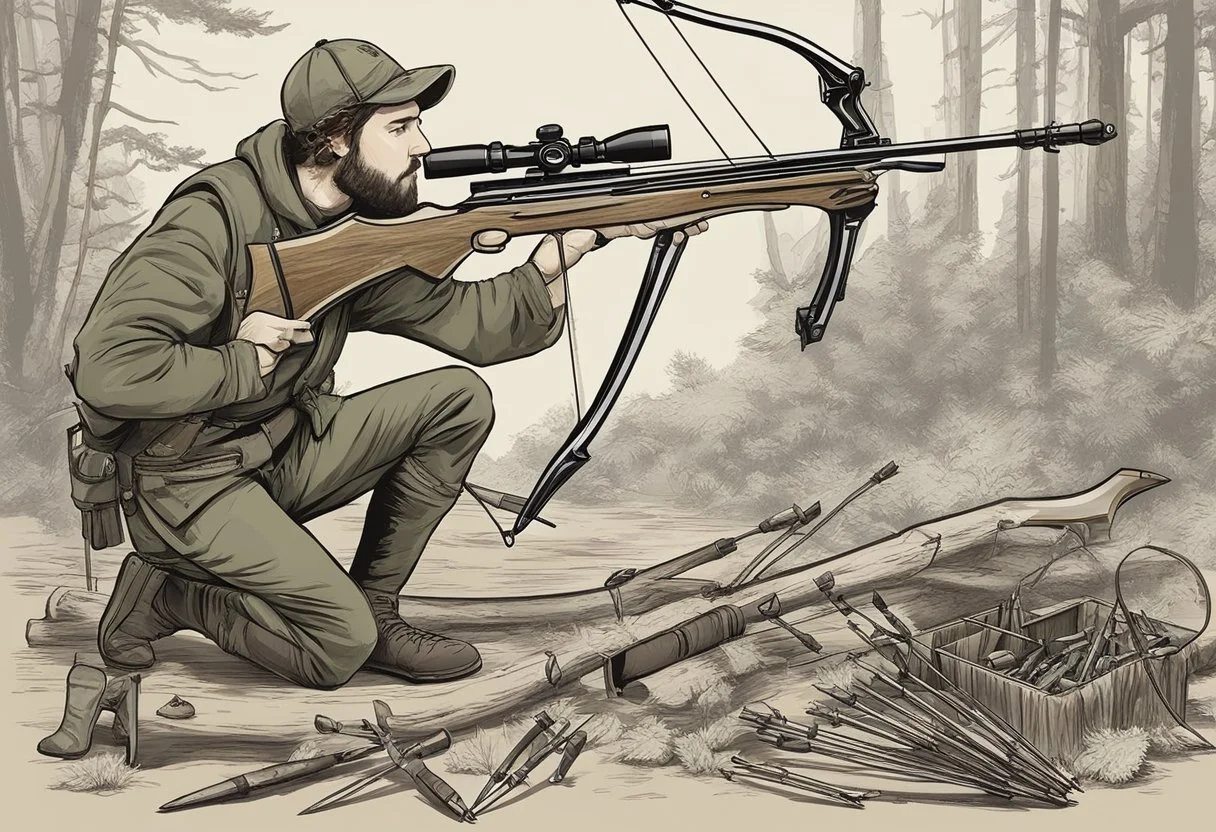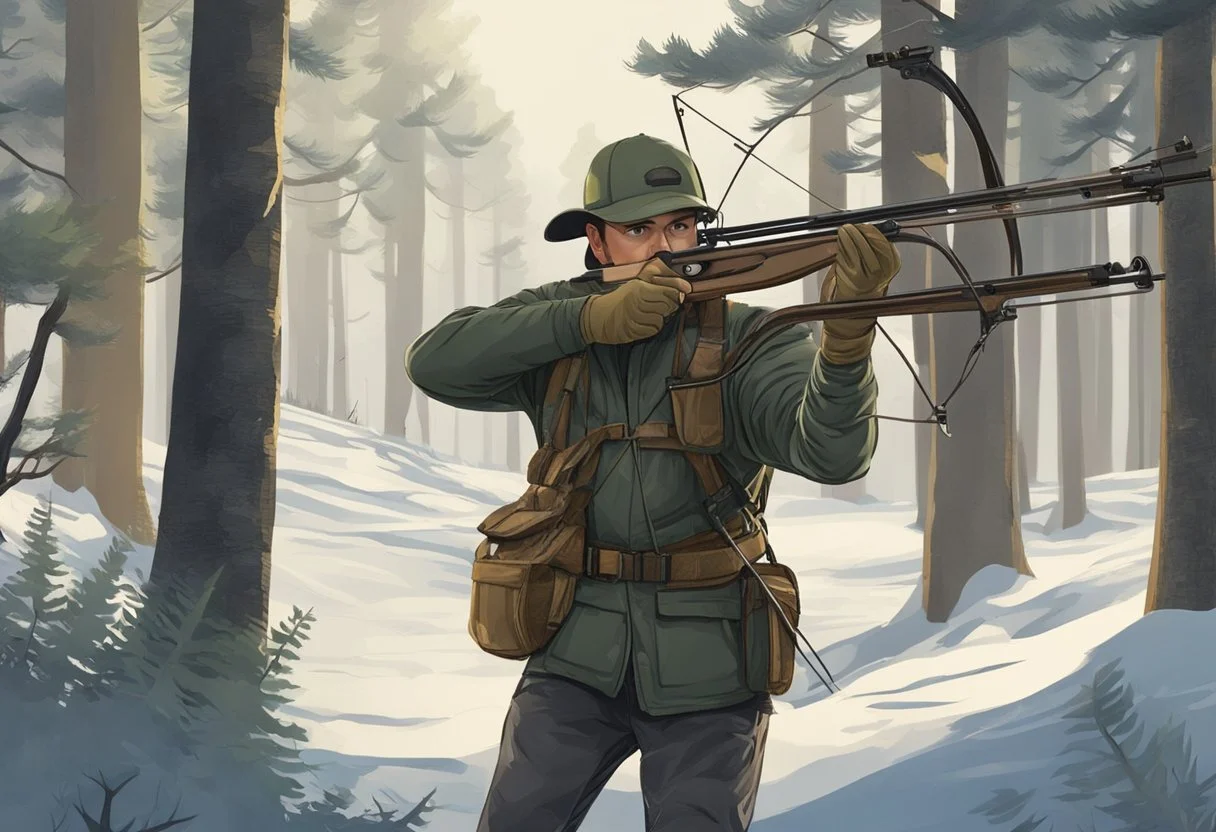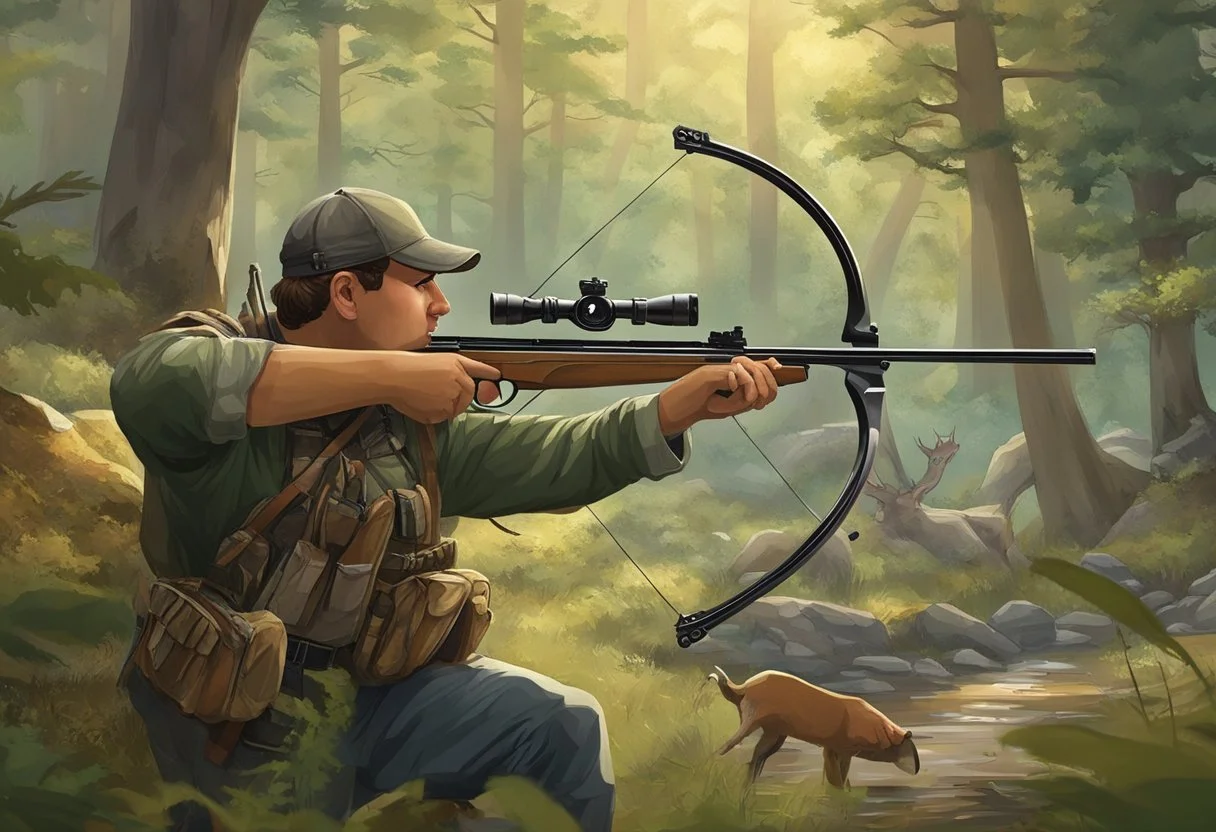Crossbow vs Bow Hunting
A Comprehensive Comparison for Hunters
Discover > Texas Outdoorsman > Crossbow vs Bow Hunting
In the world of archery, crossbows and bows have coexisted as effective hunting tools for centuries. With advancements in technology and design, both weapons have evolved, creating plenty of debate among hunters and enthusiasts alike: which is better for hunting - crossbows or traditional bows?
Crossbows and bows, although similar, have distinct advantages and disadvantages for different preferences and skill sets. While crossbows generally offer increased power and accuracy, their weight and bulk can be a drawback. On the other hand, a vertical bow, such as a compound bow, boast faster shooting speeds and better maneuverability but require more practice to master.
Considering the trade-offs between these two types of archery equipment, the choice between a crossbow and a vertical bow depends on the hunter's experience, preferences, and hunting objectives. Assessing your own skills and goals is essential to establish the right hunting bow for your personal requirements.
Understanding the Basic
Overview of Bows
Bows are some of the oldest types of projectile weapons. There are various designs but generally, bows can be categorized into three types: longbows, recurve bows, and compound bows.
Longbows are the simplest design, made from a single piece of wood. They have a narrow and long D-shape, with the string connecting directly to the limbs, which flex when the string is pulled back.
Recurve bow are similar to longbows, but the limbs curve away from the user. This design allows for greater energy to be stored in the limbs, resulting in faster arrow speed. Recurve bows are utilized in Olympic archery events due to their precision and quick shots.
Compound bow has a more modern design, incorporating cables and pulleys to increase the efficiency of energy transfer. It stores more energy and delivers it efficiently to the arrow, boasting higher accuracy and speed.
Overview of Crossbows
Crossbows come in two main types: recurve crossbow and compound crossbow. Crossbows are essentially a bow mounted horizontally on a stock, allowing the user to shoot arrows, also known as bolts.
A recurve crossbow has relatively long limbs, which curve away from the user. These crossbows store more energy as the limbs flex. However, the recurve crossbow's design requires more strength to cock due to increased draw weight.
A compound crossbow uses cables and pulleys, similar to a compound bow, to deliver more efficient energy transfer with less draw weight. These crossbows are generally faster and more accurate than their recurve counterparts.
Both bows and crossbows play a significant role in the world of archery, with the choice between them depending on factors such as personal preference, intended use, and experience level.
Hunting Fundamentals
Hunting with Bows
When it comes to bow hunting, hunters typically choose between two main types of bows: the longbow and the recurve bow, both vertical bows. Both have been used for centuries and are known for their elegance and simplicity.
Longbows have a draw weight ranging from 30 to 60 pounds and a length of about 72 inches. Their effective hunting range is 20-30 yards. On the other hand, recurve bows, used as early as the 7th century BCE, have curved ends that bend away from the archer.
Hunters who choose to use bows need to practice regularly to maintain accuracy and proficiency. It takes time, and patience to develop the skills for successful bow hunting. Bowhunters must also consider factors such as target distance, arrow trajectory, and understand game animal behavior to ensure a successful hunt.
Advantages of hunting with bows include:
Stealth: The vertical bow are generally quieter than crossbows, allowing hunters to remain undetected.
Challenge: The skills required to use a bow effectively can be satisfying and rewarding for dedicated hunters.
Hunting with Crossbows
Crossbows were invented in the Middle Ages as a more powerful and easier-to-use alternative to the longbow. They provide increased speed and kinetic energy for each shot, measured in feet per second (FPS) and foot-pounds of kinetic energy (FPKE), depending on the arrow's weight.
While crossbows may take less time to master compared to traditional bows, they still require practice and skill to use effectively. Hunters must learn about their crossbow's capabilities, such as its maximum effective range and accuracy.
There are also some specific advantages of hunting with crossbows:
Power: Crossbows generally deliver more kinetic energy and have a longer effective range.
Easier to learn: Crossbows are relatively easier to use, making them more accessible to beginners.
Choosing between a vertical bow and crossbow often comes down to personal preference and what the bow is going to be used for.
Comparing Performance
Speed
In terms of speed, bows and crossbows are quite different. A compound bow typically achieves a higher speed, often reaching between 280 and 320 feet per second (FPS). However, a crossbow can achieve speeds ranging from 300 to 400 FPS. It's important to note that a crossbow has a higher initial speed, while a compound bow gains its speed from drawing the string back further.
Accuracy
Accuracy is naturally crucial in bow hunting. Crossbows are generally considered more accurate than the compound bow due to their design, which includes a trigger system that allows for a more consistent release. However, compound bows can also be accurate with enough practice. Experienced archers are able to achieve impressive accuracy with both a vertical bow and a crossbow.
Crossbow: Higher accuracy due to a trigger system
Compound bow: Can be highly accurate with enough practice and skill
Range
The effective range of bows and crossbows varies depending on factors such as the shooter's skill, arrow type, and environmental conditions. The compound bow has an effective range of 30 to 60 yards, while a crossbow can often reach 40 to 80 yards with proper practice.
Power
Power relates to the amount of force a bow can deliver to an arrow or the power stroke. A crossbow tends to have higher power than a compound bow, due to their heavier draw weight and shorter power stroke. This enables them to deliver more energy on firing, resulting in better distance. The compound bow still has enough force for hunting most game animals.
Kinetic Energy
The effectiveness of an arrow on impact is measured in kinetic energy. It is calculated from the arrow weight and velocity. Higher kinetic energy translates to greater target penetration when hunting. Crossbows produce higher kinetic energy, as they are able to fire arrows at higher velocities compared to compound bows.
There are noticeable differences between the crossbow and the compound bow, however, the choice ultimately depends on personal preference, hunting style, and experience.
Weighing the Costs
When considering bows and crossbows for hunting, it's important to factor in the costs associated with each. This is an overview of pricing:
Price of Bows
Bows come in a variety of types, such as recurve bow, compound bow, and longbows. Prices vary depending on the type of bow, its materials and manufacturer. Entry-level bows range from $100 to $400. More advanced bows with specialized materials and features start at $500 and up. Arrows, quivers, bowstrings, and armguards are also required accessories that need to be factored in.
Price of Crossbows
Crossbows tend to be more expensive than bows due to their construction complexity. A crossbow typically starts at around $300 and can go up to $2,000 or more for high-end options.
Crossbows also require accessories such as bolts, quivers, and scopes, which can add to the overall cost. With their inherent slower reload and heavier draw weight, crossbows may require more maintenance and repair during the archery season, which can affect ongoing costs.
Ease of Usage
Learning to Use Bows
When it comes to ease of use, the traditional bow and the compound bow both require practice and skill to master. Beginners may find it challenging initially, as archery demands good body posture, controlled breathing, and precise aim. Regular practice and coaching can help develop these skills.
For instance, the traditional bow is relatively simple in design, making it more straightforward for beginners to learn. However, it necessitates a greater degree of physical strength and coordination. On the other hand, the compound bow has more technology and can take longer to learn due to features like cams and pulleys. Nevertheless, these features make drawing and holding the string less demanding, making for better control.
Key factors for learning to use bows:
Requires regular target shooting practice
Good body posture and controlled breathing
Physical strength and coordination needed
Learning to Use Crossbows
Crossbows offer a different learning curve compared to the compound bow. Often, they're considered easier for beginners, due to their similarity to a firearm. Their trigger mechanism makes the act of shooting more familiar to those with experience in handling guns. Also, crossbows offer more stability, as they are often supported against the shoulder during shooting.
However, crossbows can be heavier and bulkier, which might be a challenge with maneuverability and transport. Maintaining and adjusting a crossbow is also essential to ensure accurate shooting.
Key points for learning to use crossbows:
Easier for beginners to pick up
Similar to firearms with a trigger mechanism
Greater stability during shooting
Heavier and bulkier, can affect maneuverability
In summary, the learning curve and ease of use vary between bows and crossbows. Bows demand physical strength, coordination, and consistent practice, while crossbows are generally easier to learn for beginners familiar with firearms but can be more cumbersome to handle.
Considering Safety
Safety Measures with Bows
When it comes to bow hunting, there are a few basic safety measures that need to be considered:
Proper technique: Using the correct form while shooting a bow reduces the chance of injury, ensures you have a safe and controlled shot.
Equipment check: Regular inspection of the bow, strings, and arrows can prevent accidents caused by faulty or damaged equipment.
Safety gear: Wearing a protective armguard and finger tab protects your forearm and fingers from injuries due to the string's recoil.
In addition, be aware of your surroundings while hunting with a bow. Make sure you have a clear line of sight and be aware what's beyond the target.
Safety Measures with Crossbows
Crossbows have their own set of safety guidelines, which include:
Cocking devices: Utilize cocking devices to ensure even and controlled tension. This not only improves accuracy, but also minimizes the risk of accidental misfires or injuries.
Stock precautions: Always keep your fingers below the rail on the stock. This lowers the chance of injuries caused by accidental release.
Equipment inspection: Regularly check the crossbow and its components for any signs of wear or damage that could lead to malfunction or accidents.
Safety mechanisms: Modern crossbows often come with built-in safety features, such as anti-dry fire systems, which prevent the release of the string without a bolt loaded.
Exploring Accessories
When it comes to bow hunts and crossbow hunts, having the right accessories can significantly improve your performance and can all be purchased in your local archery shop. This section explores essential accessories for both bows and crossbows.
Bow Accessories
Quiver: A quiver is a container used to hold and transport arrows, made in various designs, such as back or hip quiver. The right quiver will help you easily access your arrows while hunting.
Sights: Sights are essential for accurate shooting, enabling better aim. Some popular types of bow sights include pin sights, pendulum sights, and target sights.
Arrow rest: The arrow rest is a device attached to the bow riser, which provides support for the arrow. Popular types of arrow rests include capture rests, drop-away rests, and shoot-through rests.
Release aid: A release aid is a mechanical device that releases the bowstring with a trigger mechanism, providing a smoother release and a more accurate shot. There are several types of release aids, like wrist-strap and finger releases.
Stabilizers: These accessories balance the bow, reducing vibration and noise while making it easier to hold the bow steady during a shot. They come in various lengths and weights.
Bow case: To safely transport and protect your bow, a bow case is crucial. These cases are designed to fit either compound bows or recurve bows and are available in various materials.
Crossbow Accessories
Scopes: Crossbow scopes are specifically designed for aiming crossbows. They come in many types, including red dot and reticle scopes. Scopes enhance range estimation and give a clear target view for long-distance shots.
Cocking devices: Cocking devices make it easier and more consistent to draw a crossbow's string. Popular types include rope cocking aids and crank cocking devices.
Broadheads: Broadheads are the sharp, cutting edges attached to the tip of an arrow or bolt. They come in various designs, like fixed-blade, mechanical, and hybrid broadheads.
Bolt case: Similar to a bow case, a bolt case is designed to protect and transport your crossbow bolts safely. It helps in organizing your bolts and keeping them in good condition.
Quiver: Just like for bows, a quiver is essential for crossbow hunts as well. Crossbow quivers are designed to hold bolts, which are shorter than arrows. They can be mounted directly on the crossbow or carried separately.
Pros and Cons of Bow Hunting
Compound Bows have been popular for centuries, the different equipment offers advantages and disadvantages to those who engage in the sport. These are some of the advantages and disadvantages:
Pros:
Challenge: Compound bow hunting is often considered a more challenging and rewarding experience compared to using firearms or crossbows. The need for maintaining proper form, stance, and precision in aiming adds complexity that many hunters enjoy.
Quiet: Compound bows are quieter than firearms and crossbows. This offers hunters closer encounters with wildlife and a more immersed experience in nature.
Form and Stance: Bow hunting requires a correct stance and form to effectively shoot with accuracy. These skills translate to increased overall body strength, balance, and discipline, which can be beneficial outside of hunting.
Reliable: With fewer moving parts than crossbows, the compound bow is generally considered more reliable. They are less likely to experience mechanical failure in the field, assuming proper maintenance is practiced.
Cons:
Draw Weight (DW) and Let-Off: The DW of a bow, or the amount of force needed to pull the string back, can be significantly higher than that of a crossbow. Additionally, while a compound bow offers a let-off in DW (usually 60%-90%), it still requires more effort to hold the string at full draw than a locked crossbow.
Limited Shooting Length: Bow hunting generally requires hunters to be at a closer range to their target compared to crossbows or firearms. This may make it more challenging to successfully take a shot at a wary game animal.
Aiming and Shooting Time: Unlike a crossbow, which can be cocked and ready to fire with minimal movement, drawing compound bows takes time. This can potentially spook the animal and result in a missed opportunity. Moreover, maintaining drawn position for an extended time can be physically taxing for the hunter.
Safety Concerns: Bow hunting carries certain risks due to the need to draw and hold the string, which can result in potential accidents if the hunter loses control of the bow, or if the string snaps during use.
Pros and Cons of Crossbow Hunting
Crossbow hunts have grown in popularity over the years, with more and more hunters considering the switch from standard bows. This section will provide a brief overview of the pros and cons of crossbow hunting, focusing on aspects such as power, accuracy, maintenance, and restrictions.
Pros
Power and Accuracy: Crossbows offer greater power and accuracy compared to standard bows. The mechanical advantage provided by their pulley and cam system allows for higher DWs and faster arrow speeds, resulting in more powerful and precise shots. The use of bolts (shorter, heavier arrows) also contributes to increased accuracy.
Stability: Crossbows often come with a built-in rest, similar to a rifle stock, which provides stability when aiming and shooting. This aspect is particularly advantageous for those new to archery, as well as for hunters experiencing fatigue during a longer hunting experience.
Ease of Use: The trigger mechanism on a crossbow allows hunters to shoot in a manner similar to using a firearm. This can make the learning curve shorter and improve consistency in shot placement. Additionally, the crossbow can be held at full draw without continuous physical exertion, allowing the hunter to take their time lining up the perfect shot, especially useful in cold weather.
Cons
Weight and Bulk: Crossbows tend to be heavier and bulkier than standard bows, making them more difficult to carry and maneuver in the field. Their size can also make them more challenging to use in tight spaces or thick cover.
Noise: When compared to a traditional bow, crossbows generate more noise, which can potentially startle the game and decrease the chances of hitting the intended target.
Maintenance: Crossbows require more maintenance compared to standard bows, due in part to the presence of additional moving parts, such as the trigger mechanism. Proper care is essential to ensure the longevity and optimal performance of the crossbow.
Restrictions: Not all jurisdictions permit crossbow hunts. Before heading out to hunt with a crossbow, it is crucial to check local regulations and obtain any necessary permits or licenses. Some in the hunting community may have additional restrictions on DW or the use of certain types of broadheads.
Ethical Kill Considerations: The increased power of the crossbow is a double-edged sword. While it boosts the chances of a clean, ethical kill when used skillfully, it can also cause unnecessary damage and suffering if the shot placement is poor or if the arrow does not pass through the animal efficiently. Responsible and thoughtful hunting practices are imperative to avoid any negative outcomes.






